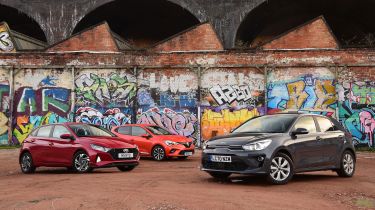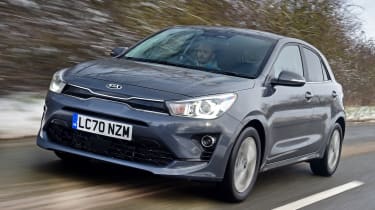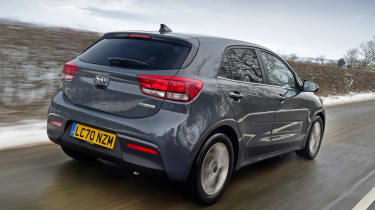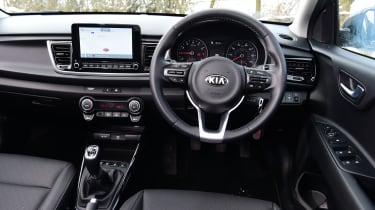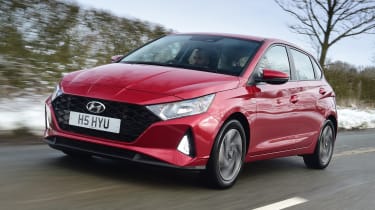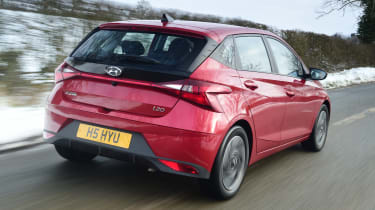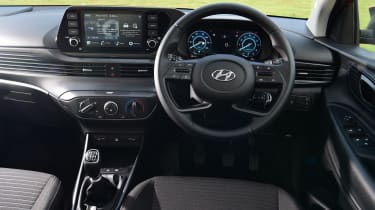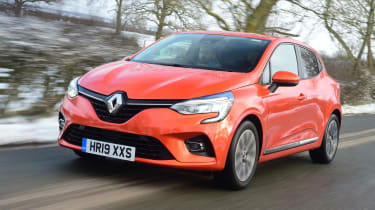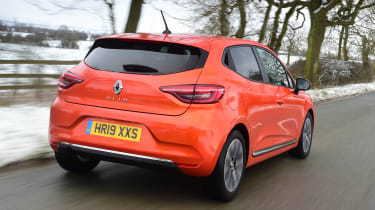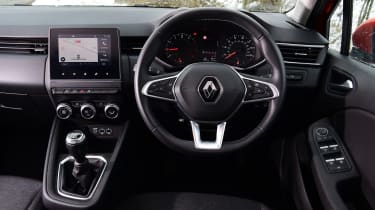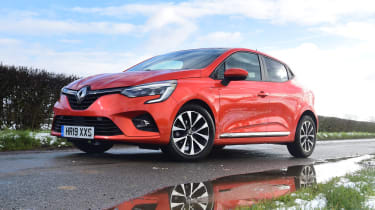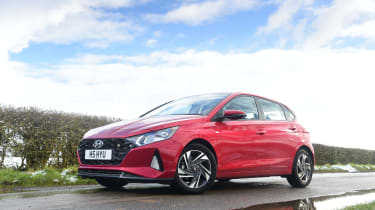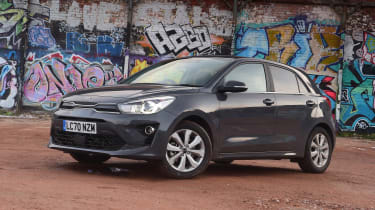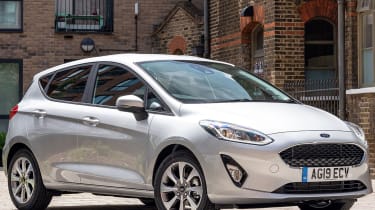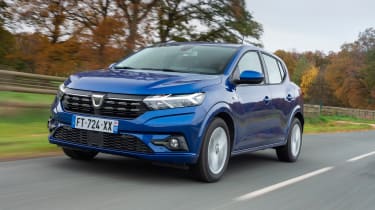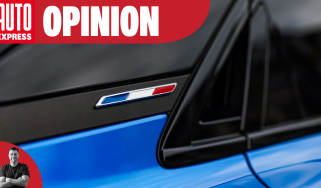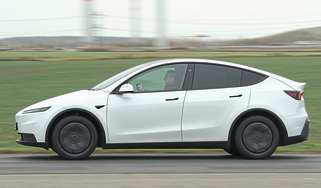Kia Rio vs Hyundai i20 vs Renault Clio
Can the new Kia Rio challenge the Renault Clio and Hyundai i20 for supermini honours?
Kia is undergoing quite a transformation. The firm is rolling out a new logo, there’s a fleet of advanced EVs in the pipeline, and its design team is creating some of the most eye-catching cars on sale.
However, at its core Kia is known for developing affordable and reliable cars. The Rio has been central to those values for years, and in a bid to keep it fresh Kia has updated the supermini with a subtle exterior redesign and introduced new mild-hybrid tech.
Up against the new Hyundai i20 and Renault Clio, however, the Rio has some seriously stiff competition. The French supermini sets the benchmark in this class when it comes to style, refinement and technology, three key areas buyers consider when in the market for a supermini. It’s the current Auto Express Supermini of the Year.
What Hyundai has developed with the i20 is nothing short of astonishing. What was once a dumpy and forgettable supermini has been transformed into a fantastic little runabout.
These two models represent the very best that is currently on offer in the supermini market, so if the updated Rio is to succeed it has to be able to compete with these two class leaders.
Kia Rio
| Model: | Kia Rio 1.0 T-GDi 118bhp 48V 3 |
| Price: | £19,145 |
| Engine: | 1.0-litre 3cyl turbo, 118bhp |
| 0-62mph: | 9.8 seconds |
| Test economy: | 39.7mpg/8.7mpl |
| CO2: | 122g/km |
| Annual road tax: | £175 |
The fourth-generation Kia Rio was launched in 2017, so this latest car is a thorough refresh rather than an all-new model. The big news is the arrival of a mild-hybrid 1.0-litre engine for the first time. Yet the engine is only offered in 3 trim and above, which makes the Kia the priciest of this trio, at £19,145.
Used - available now

2022 Peugeot
3008
27,968 milesManualDiesel1.5L
Cash £16,387
2022 Nissan
Qashqai
36,550 milesManualPetrol1.3L
Cash £14,497
2022 Ford
EcoSport
21,804 milesManualPetrol1.0L
Cash £12,197
2019 Mazda
3
60,745 milesAutomaticPetrol2.0L
Cash £12,197Design & engineering
The supermini class is so crowded it’s often easy to overlook some cars that have been around for decades; the Kia Rio is one of them. It first arrived back in 1999 but has fallen by the wayside amid a flurry of stylish and affordable models from rival manufacturers.
The latest fourth-generation version has received a mechanical and visual update. The exterior makeover isn’t drastic but Kia has added a more prominent version of its Tiger Nose grille and reshaped the front bumper. The Rio still looks rather anonymous to our eyes, especially up against something as handsome as the Clio and eye-catching as the i20.
Inside, there’s a smattering of new materials aimed at making the Rio feel a bit more upmarket and an updated eight-inch infotainment system.
The biggest revamp with the Rio, however, is what you can’t see; under the skin engineers have fitted the supermini with a new 1.0-litre three-cylinder mild-hybrid powertrain. It’s exactly the same unit that you’ll find in the i20 we’re testing here, too.
It develops a modest 118bhp and 172Nm of torque, and comes paired with Kia’s clever six-speed ‘Intelligent Manual Transmission”. It acts in every way like a normal manual gearbox but there is no physical connection between the clutch pedal and the clutch itself. Instead, the movement of your left leg is relayed electronically. The main benefit is that the engine is able to shut down and coast when you lift off the throttle, which boosts fuel economy.
Driving
If you were hoping the Rio’s rather anonymous looks were going to be offset by excellent driving dynamics, well, you’re going to be disappointed. That’s not to say that the Rio is a bad car to drive, it’s perfectly acceptable, but with such rich and accomplished opposition in the class, like the Clio and i20, the Rio really needs to do more to stand out.
A strong point is that new 1.0-litre mild-hybrid engine. It feels sprightly, developing 118bhp, and is the quickest car of the three, hitting 0-62mph in 9.8 seconds. It feels it too, with decent shove low down in the rev range, which gives plenty of flexibility when accelerating up to motorway speeds. Extend the engine right up to 6,000rpm and it does sound a little coarse, but as the bulk of the motor’s power has been accessed by 4,000rpm there is little need to rev the engine beyond that point. By comparison, the Clio’s three-cylinder engine is a lot quieter at speed.
The Kia’s mild-hybrid system is another plus point in its favour, because the only time you’ll notice the engine cutting out is when you see the rev needle drop. You can’t feel or hear the system at work, such is its seamless integration.
Less impressive, however, is the Rio’s steering and suspension set-up. Again, it’s not bad, but the ride is firmer than that in the Clio, fidgeting over slight bumps and ripples in the road surface. It’s comfortable enough but the quality of the ride doesn’t challenge the class leaders here.
The steering, meanwhile, is very light and devoid of feel. It makes manoeuvering at city speeds a breeze, but there’s not much enjoyment to be had behind the wheel on faster, winding roads.
Practicality
Only a few millimetres separate the Rio from the i20 and Clio, but the Kia is the least practical of the three superminis. The 325-litre boot isn’t small, but it’s almost 70 litres down on what you get in the Clio, which is quite a lot given the relatively small dimensions of the cars.
And don’t think the trade-off is more rear passenger space; there’s just as much room in the back of the Rio as the i20, which again has a larger boot than the Kia. Head and kneeroom are both pretty good: you can sit two adults back there in relative comfort, but three would be a squeeze.
One benefit of the Kia is that when you drop the rear bench it lies almost flat – handy for loading longer, bulky items – and the 1,103-litre load bay is bigger than that in the Clio with the seats folded.
Ownership
One major draw for buyers here is Kia’s seven-year/100,000-mile warranty; few other brands offer such attractive cover. Not that you’re likely to have to make much use of it, because Kia has built up a solid reputation for reliability; in our Driver Power 2020 survey, Kia finished in second position. The dealer network is also highly rated, finishing fifth in our survey, too.
The mild-hybrid model we have here is only available from Kia’s upper-spec 3 trim, so there’s no shortage of safety kit; Forward Collision-Avoidance Assist (FCA), Lane-Follow Assist (LFA) and cruise control are all included as standard.
Running costs
Despite the trick mild-hybrid powertrain the Rio returned 39.7mpg on our test, the lowest of the three cars here. However, there wasn’t a great deal in it and it’s likely that the Kia’s extra power counted against it here.
It means that, over 12,000 miles you’ll spend around £1,649 on fuel, almost £300 more than you would in the more fuel-efficient Renault Clio.
The slightly higher CO2 emissions of 122g/km mean the Rio will be marginally more expensive than its two rivals here to run as a company car, at £1,022 and £2,044 annually for the standard and higher-rate taxpayer respectively. The Hyundai will cost £956 and £1,911, and the Renault £903 and £1,806 annually in Benefit-in-Kind contributions.
Testers’ notes
“The six-speed iMT is a great gearbox, but Kia does offer buyers the option of a DCT automatic transmission for a £1,000 premium on 3-spec versions of the Rio hatchback.”
Hyundai i20
| Model: | Hyundai i20 1.0 T-GDi 100 Hybrid SE Connect |
| Price: | £18,595 |
| Engine: | 1.0-litre 3cyl turbo, 99bhp |
| 0-62mph: | 10.4 seconds |
| Test economy: | 45.2mpg/9.9mpl |
| CO2: | 115g/km |
| Annual road tax: | £175 |
Hyundai really upped its game with the latest i20, taking what was a forgettable supermini and transforming it into a challenger in this class. Here in entry-level SE Connect specification it’s also great value, starting at £18,595, and comes fitted with the same mild-hybrid technology offered in the Kia.
Design & engineering
Although they look very different, the i20 and Rio share a lot in common. They use the same basic architecture, the same 1.0-litre engine and six-speed iMT manual gearbox. Yet Hyundai has managed to use the tools at its disposal to produce a supermini that is slightly smaller but more practical than the car from its sister brand.
The i20 was the first of the two to use the 1.0-litre mild-hybrid powertrain, which is supported by a 48-volt electrical system and integrated belt-starter generator. As with the Kia, the system uses a small lithium-ion battery, located in the boot floor, which has enough juice to run components like the power steering, allowing the engine to shut down while coasting to save fuel.
Yet the i20 uses a slightly less powerful version of that engine, developing 99bhp but an identical 172Nm of torque. Acceleration is marginally affected but fuel economy takes a boost as a trade-off.
While the running gear is the same, one area the i20 does have the Kia beaten is standard equipment levels, despite being cheaper. The Hyundai gets a set of slick 10.25-inch digital dials as standard, yet they aren’t even an option in the Rio. But while there is
an eight-inch infotainment system fitted, it comes without sat-nav in SE Connect trim. Apple CarPlay and Android Auto are both fitted as an alternative, so buyers can plug in their smartphone and access navigation that way when necessary.
The i20’s cabin is perhaps a bit of a weak point. While the infotainment and digital dials are great, the rest of the interior is covered in hard, scratchy plastics that make it feel cheap. It certainly feels built to last, that’s for sure, but up against the Clio in this test its shortcomings on fit and finish are highlighted.
Driving
Where the little Hyundai has come on leaps and bounds is from behind the wheel: this is a car that now drives as sharply as it looks. It’s not quite as entertaining as a Ford Fiesta, but given what the old i20 was – dull and forgettable – it’s a huge improvement.
Like all of the cars in this test, the i20’s suspension comprises MacPherson struts up front and a torsion-beam rear axle. But it’s more than 100kg lighter than its two rivals and that can really be felt with the way the i20 covers ground. It’s smooth and compliant over most surfaces, with the softer set-up taking the sting out of any nasty potholes on the move.
But that’s not at the expense of body control, so when you up the pace and ask for faster changes in direction through corners the i20 feels up to the job and not out of its depth. The steering has a nice weight and it’s consistent from turn to turn, which allows you to point the car’s nose precisely into corners.
Performance from the 1.0-litre mild-hybrid engine can’t be described as anything more than adequate, with a 0-62mph time of 10.4 seconds. In truth, the i20 feels faster than that number suggests, with a decent wave of torque available from 1,500rpm; it means the engine revs keenly and smoothly helped by that added electrical assistance.
It’s a very quiet engine, too, more so than that in the Rio, so it makes for a competent motorway cruiser at higher speeds. A bonus here is the ‘sailing’ function when you lift off the throttle; the engine is able to cut out completely, thanks to the 48-volt electrics. As in the i20, it’s a brilliantly integrated system and the only time you’ll notice it working is when a small ‘sailing flash’ illuminates on the digital dials.
Practicality
The i20 may be a little shorter than the Rio but the wheelbase is identical at 2,580mm. There’s almost nothing between them when it comes to passenger space, so two adults will fit without any problems in the rear.
Where the i20 does get one over the Rio is boot capacity: the Hyundai can muster 352 litres against the Kia’s 325 litres. The door bins can swallow a one-litre bottle and there’s a couple of cup-holders down on the centre console. However, there is no armrest or storage bin between the seats in the i20. It’s hardly a deal-breaker but it means keeping your valuables out of sight is a pain, so they need to be tucked away in the glove compartment instead.
Ownership
A big pull for buyers here is Hyundai’s five-year/unlimited-mileage warranty, even if it’s not as long as Kia’s deal. Hyundai lingers in mid-table in our Driver Power poll in 13th, behind Kia but ahead of Renault.
The i20 hasn’t yet been tested by Euro NCAP but based on the level of safety kit, and Hyundai’s reputation for safety, it should achieve a very good rating. All i20s feature Autonomous Emergency Brake (AEN), Driver Attention Alert (DAA), Forward Collisions Assist (FCA) and Lane-Keep Assist (LKA) with Lane Departure Warning (LDW).
Running costs
THE i20 averaged 45.2mpg on test, which is around 10mpg down on the official claim, but a slightly better performance than what we saw from the Rio. Hyundai’s more modest kerbweight certainly helped it there. It means that over the course of
a year you’ll spend around £1,450 on fuel if you average 12,000 miles per year.
The i20’s lower CO2 emissions of 115g/km help sneak it into a lower Benefit-in-Kind bracket (26 per cent) than the Rio (27 per cent) for company car users. It means the i20 will cost lower-rate taxpayers £956 per year rather than the £1,022 required by the Kia.
Testers’ notes
“The battery for the 48-volt mild-hybrid system sits beneath the boot floor, so there is no space-saver spare wheel. Instead buyers get a repair kit.”
Renault Clio
| Model: | Renault Clio TCe 100 Iconic |
| Price: | £17,595 |
| Engine: | 1.0-litre 3cyl turbo, 99bhp |
| 0-62mph: | 11.8 seconds |
| Test economy: | 48.2mpg/10.6mpl |
| CO2: | 119g/km |
| Annual road tax: | £175 |
We’re already pretty familiar with the latest Renault Clio. The current Auto Express Supermini of the Year sets the benchmark for a number of reasons, chief among which are its excellent value for money, its class-leading practicality, and its genuinely premium feel. In mid-level Iconic trim it’s the cheapest car of the three here, starting from £17,595
Design & engineering
The latest Clio marked a big departure from the model that came before it and key to that transformation was the switch to the Groupe Renault’s new CMF-B platform. It sits between the Rio and i20 in terms of size but is by some margin the most practical. Clever packaging has allowed engineers to free up more boot space and passenger room than its two rivals here.
Renault does offer the Clio with a complex but highly efficient hybrid powertrain, but the version we have here is the tried-and-tested 1.0-litre TCe three-cylinder that develops 99bhp and 160Nm of torque. It only comes paired with a five-speed manual gearbox, whereas its rivals both get six-speed units.
It’s also the slowest; Renault claims 0-62mph in a leisurely 11.8 seconds. But performance is not where the manufacturer has chosen to focus with the Clio: refinement and comfort are where the French supermini really excels.
That’s evident immediately when you climb inside, because the Clio feels the most premium of the three cars on test. Sure, there’s a lot of plastic dotted around the cabin – that’s to be expected in a supermini – but the materials used are of higher quality and look a lot more pleasing on the eye.
Of course, styling is subjective, but finished in the striking orange paintwork the Clio really stands out in this test. It is a £660 option but it really does help the Renault hatchback make a lasting impression.
Driving
You don’t have to cover many miles in the Clio to work out that it feels and drives like one of the most premium and accomplished superminis on the market. There’s little attempt to inject any sort of performance or sportiness into the driving experience, instead Renault’s engineers have focussed on making the model as relaxing and comfortable to drive as possible.
The 1.0-litre TCe engine is very smooth and quiet although it does feel a little underpowered, developing only 99bhp and 160Nm of torque. A little more power would be welcome – Renault says 0-62mph takes 11.8 seconds – because it’s easily the slowest car of our test trio.
However, once up to speed the Clio feels the most stable and has the best ride quality, always feeling supple and controlled. Even though it only gets a five-speed manual transmission, the engine fades away into the background, which makes motorways journeys no trouble at all.
There’s not an awful lot of feeling in the steering but it’s consistently weighted from turn to turn, and that lack of power means the Renault isn’t the most involving car to drive down a B-road, however the Clio’s greater focus on comfort and overall refinement is a worthy trade-off.
Practicality
If you want as much space for as little money as possible, then the Clio is the supermini for you. Although it’s not a physically larger car than its two rivals here, Renault has managed to liberate much more space inside for passengers and all of their luggage.
There’s a good amount of space up front with a big glovebox and wide door bins for large bottles. Space in the rear is also impressive with plenty of room for two six-foot adults. The Clio is also the best suited for those who want to carry three passengers in the back because shoulder room is more generous.
Where the Clio really gets one over its rivals is boot capacity. At 391 litres, there’s more space in the back of a Clio than a Volkswagen Golf, and that sits in the class above. Plus, there’s a split-level boot floor – neither the Kia or Hyundai feature this – which is handy for keeping valuables out of sight. However, dropping the seats does leave quite a large step between the boot floor and seat back.
Ownership
While the Clio is clearly an accomplished supermini, the same can’t be said of Renault as a brand and its dealer network. The French company finished 15th out of 30 in our Driver Power 2020 brands survey and its franchise network 22nd out of 25.
Renault offers an industry-standard three-year/60,000-mile warranty, which isn’t as generous as those offered by Kia or Hyundai.
Standard safety kit is pretty generous though, with Lane Departure Warning, cruise control, rear parking sensors, full LED head and tail-lights and traffic-sign recognition all featuring. And out of the three cars here, the Clio is the only one that comes with the option (£200) of a space-saver spare wheel.
Running costs
Despite not featuring any clever mild-hybrid technology, the Clio was actually the most efficient vehicle on our test, returning 48.2mpg. That’s only fractionally off Renault’s official claim of 52mpg. It means that over 12,000 miles you’ll spend £1,358 on fuel, the lowest out of the three cars on test.
Another bonus is the Clio’s CO2 emissions of 119g/km, which mean it sneaks into the 26-per-cent Benefit-in-Kind tax bracket. Coupled with its lower price tag, it is also the cheapest car here for business users; lower and higher-rate earners will pay only £903 and £1,806 per year respectively.
That’s a £119 annual saving over the Rio for those company car drivers in the lower tax bracket.
Testers’ notes
“The Clio is the only one of the three superminis here that is offered with the option of a diesel engine. However, even in entry-level Play spec the Blue Dci 85 engine costs from £19,494.”
Verdict
First place: Renault Clio
Once again the Renault Clio hangs on to the top spot, but only just. As an all-rounder the Clio is a truly excellent supermini, wrapping up strong technology, great practicality and first-rate refinement in an eye-catching package. This TCe 100 engine is a little on the sluggish side, but the trade-off is a level of comfort and composure you’d expect from the class above. It’s also very well equipped and the cheapest model to buy and run.
Second place: Hyundai i20
The gap between first and second here is very narrow, which goes to show just how much improved the latest i20 is. What was once a dour and forgettable car has transformed into a genuinely recommendable supermini that can cut it with the best of them. The mild-hybrid powertrain is very well refined and powerful enough, while the tech is among the best here. However, cheap interior materials let it down.
Third place: Kia Rio
The Rio may be the newest car here but it doesn’t feel like it. Against such accomplished opposition it feels dated and behind the curve. Its design is about as uninspiring as the way it drives, and even with advanced mild-hybrid technology it was the least efficient of the cars on our test. It’s also the most expensive to buy and own, which cements its place at the bottom of the pile.
Also consider...
Ford Fiesta
- Model: Ford Fiesta Titanium 1.0 EcoBoost
- Price: £20,060
- Engine: 1.0-litre 3cyl, 125bhp
Still the class benchmark for ride and handling, the Fiesta remains a cracking all-round supermini. Improved tech inside and new mild-hybrid powertrains bring it bang up to date with its newer rivals here. Yet the list prices are steadily increasing.
- Model: Dacia Sandero TCe 90 Comfort
- Price: £11,595
- Engine: 1.0-litre 3cyl, 90bhp
The new Sandero could spell big trouble for established rivals, because while it’s gone upmarket with new tech, engines and infotainment, its price tag hasn’t. It’s almost half the Rio’s cost and a lot cheaper on a monthly PCP deal.
Figures
| Renault Clio TCe 100 Iconic | Hyundai i20 1.0 T-GDi 100 Hybrid SE Connect | Kia Rio 1.0 T-GDi 118bhp 48V 3 | |
| On the road price/total as tested | £17,595/NA | £18,595/£19,145 | £19,145/£19,145 |
| Residual value (after 3yrs/36,000) | £8,322/47.3% | £8,405/45.2% | £9,094/47.5% |
| Depreciation | £9,273 | £10,190 | £10,051 |
| Annual tax liability std/higher rate | £903/£1,806 | £956/£1,911 | £1,022/£2,044 |
| Annual fuel cost (12k/20k miles) | £1,358/£2,264 | £1,448/£2,414 | £1,649/£2,748 |
| Insurance group/quote/VED | 10/£443/£175 | 13/£476/£175 | 9/£411/£175 |
| Cost of servicing | £449 (3 years) | £522 (3 years) | £489 (3 years) |
| Length/wheelbase | 4,050/2,583mm | 4,040/2,580mm | 4,065/2580mm |
| Height/width | 1,607/1,836mm | 1,450/1,775mm | 1,450/1,725mm |
| Engine | 3cyl in-line/999cc | 3cyl in-line/998cc | 3cyl in-line/998cc |
| Peak power/revs | 99/5,000 bhp/rpm | 99/4,500 bhp/rpm | 118/6,000bhp/rpm |
| Peak torque/revs | 160/2,750 Nm/rpm | 172/1,500 Nm/rpm | 172/1,500Nm/rpm |
| Transmission | 5-speed man/fwd | 6-spd e-man/fwd | 6-spd e-man/fwd |
| Fuel tank capacity/spare wheel | 42 litres/£200 | 40 litres/repair kit | 45 litres/repair kit |
| Boot capacity (seats up/down) | 391/1,069 litres | 352/1,165 litres | 325/1,103 litres |
| Kerbweight/payload/towing weight | 1,178/513/900kg | 1,065/530/1,110kg | 1,228/422/900kg |
| Turning circle | 10.4 metres | 10.4 metres | 10.2 metres |
| Basic warranty (miles)/recovery | 3yrs (60,000)/3yrs | 5yrs (unlimited)/5yrs | 7yrs (100,000)/1yr |
| Driver Power manufacturer/dealer pos. | 15th/22nd | 13th/11th | 2nd/5th |
| NCAP: Adult/child/ped./assist/stars | 96/89/72/75/5 (’19) | N/A | 93/84/71/59/5 (’19) |
| 0-62mph/top speed | 11.8 secs/116mph | 10.4 secs/117mph | 9.8 secs/118mph |
| Auto Express econ. (mpg/mpl)/range | 48.2/10.6/445 miles | 45.2/9.9/398 miles | 39.7/8.7/393 miles |
| WLTP combined | 54.3mpg | 55.4mpg | 52.3mpg |
| WLTP combined | 11.9mpl | 12.2mpl | 11.5mpl |
| Actual/claimed CO2/tax bracket | 135/119g/km/26% | 144/115g/km/26% | 164/122g/km/27% |
| Airbags/Isofix/parking sensors/cam. | Yes/yes/yes/£400 | Yes/yes/yes/yes | Yes/yes/rear/yes |
| Auto box/lane keep/blind spot/AEB | £1,500/yes/no/yes | £1,250/yes/no/yes | £1,000/yes/no/yes |
| Clim./cruise ctrl/leather/heated seats | Air-con/yes/no/no | Air-con/yes/no/no | Auto a/c/yes/no/yes |
| Met paint/LEDs/keyless/pwr tailgate | £660/yes/yes/no | £550*/no/no/no | Yes/no/no/no |
| Nav/digi dash/DAB/connected services | Yes/no/yes/yes | No/yes/yes/yes | Yes/no/no/no/yes |
| Wireless charge/CarPlay/Android Auto | No/yes/yes | No/yes/yes | No/yes/yes |
